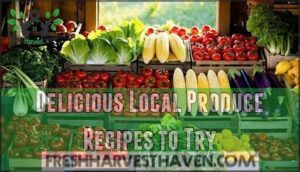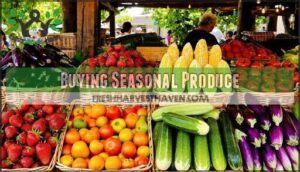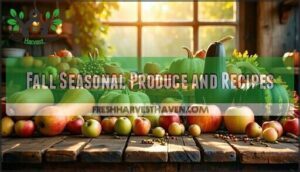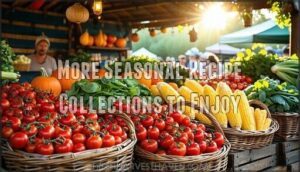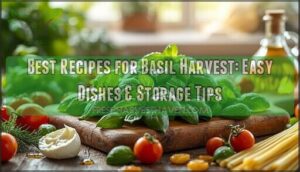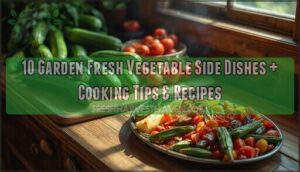This site is supported by our readers. We may earn a commission, at no cost to you, if you purchase through links.

Shopping at farmers markets becomes recipe inspiration as you discover unique varieties and get cooking tips directly from growers. When you cook with what’s in season, you’re working with nature’s timing for the best flavors and prices.
These recipes also support local farmers and build community connections through shared meals and conversations about sustainable living. The key is learning what grows when in your area and how to make the most of seasonal abundance.
Table Of Contents
- Key Takeaways
- Benefits of Local Produce Recipes
- Delicious Local Produce Recipes to Try
- Tips for Shopping at a Farmers Market
- Fall Seasonal Produce and Recipes
- Exploring Local Food in Hawaii
- Seasonal Produce in Hawaii and Recipe Ideas
- More Seasonal Recipe Collections to Enjoy
- Frequently Asked Questions (FAQs)
- Where can I find fresh local produce?
- Why should you cook with locally sourced produce?
- Why should you choose local produce?
- What is a good local food meal?
- What are examples of locally produced food?
- Is it cheaper to buy local produce?
- What are some foods you can buy that are locally produced?
- Is it better to eat local produce?
- Where is a good place to get recipes?
- Where to find quality recipes?
- Conclusion
Key Takeaways
- You’ll get better taste and nutrition from local produce since it’s harvested at peak ripeness and retains more vitamins than shipped alternatives
- You’re supporting your community’s farmers and economy with every purchase, creating jobs and preserving farmland while building stronger local connections
- Shopping at farmers markets becomes recipe inspiration as you discover unique varieties and get cooking tips directly from growers who know their produce best
- Cooking with seasonal abundance saves money while working with nature’s timing for peak flavors, whether it’s fall’s hearty vegetables or summer’s fresh fruits and herbs
Benefits of Local Produce Recipes
When you cook with local produce, you’re getting ingredients at their peak flavor and nutritional value since they’re harvested when fully ripe rather than picked early for shipping.
You’ll also support your community’s farmers and economy while reducing your environmental impact through shorter transportation distances.
Better Taste and Nutrition
When you bite into local produce, you’re experiencing peak ripeness that transforms every meal. Local ingredients ripen naturally on the vine, creating flavor profiles that store-bought produce can’t match.
Nutrient density stays locked in when harvest-to-table time shrinks to hours:
- Spinach retains 50% more vitamin C when picked fresh versus shipped produce
- Tomatoes maintain higher lycopene levels when grown locally
- Berries preserve essential antioxidants through minimal transport time
Freshness matters because nutrients start degrading immediately after harvest. Local produce recipes deliver superior taste and texture while providing genuine health benefits. You’re not just cooking—you’re maximizing nutritious meals that better taste and nutrition can offer your family.
Supporting Local Farmers and Economy
Beyond the fresh flavor of local produce recipes, your purchasing decisions create powerful economic multiplier effects throughout your community. When you buy from local farmers, you’re investing in job creation and farmland preservation that extends far beyond individual transactions.
Your dollars work harder locally, circulating through neighborhood businesses rather than disappearing to distant corporations. This local investment builds community resilience by creating interconnected support networks that benefit everyone.
Here’s how your farmers market visits strengthen the local economy:
- Direct farmer support – Each purchase helps farming families maintain sustainable operations while preserving agricultural land from development pressures.
- Community wealth building – Local food community spending generates additional jobs in processing, distribution, and retail sectors throughout your region.
Community Building and Connection
Farmers markets create connections that grocery stores can’t match. You’ll build relationships with local farmers who remember your preferences and share growing tips. These Local Events transform shopping into community building experiences where neighbors exchange recipes and cooking advice.
Fresh, local ingredients create meals that nourish both body and community connections.
Shared Meals prepared with seasonal ingredients spark conversations about sustainable living. Join Food Education workshops or Volunteer Opportunities at harvest festivals. Farm Visits and potluck dinners featuring local produce recipes strengthen your local food community bonds, creating lasting friendships through collective experiences. Starting a garden involves assessing available space for ideal growth.
Delicious Local Produce Recipes to Try
Transform your farmers market hauls into outstanding meals with these foolproof Local Produce Recipes. Fresh Ingredients from local farms deliver exceptional Local Flavors that’ll make your taste buds sing.
Here are five Seasonal Recipes you’ll love:
- Market Vegetable Stir-Fry – Perfect for Recipe Adaptations using whatever’s in season
- Farm-Fresh Tomato Salad – Simple Cooking Techniques let ingredients shine
- Roasted Root Vegetable Medley – Easy Ingredient Substitutions work with any root veggies
- Seasonal Fruit Crumble – Accommodates different Dietary Needs with gluten-free options
- Pickled Cucumber Chips – Great for Meal Planning and preserving summer’s bounty
These recipes celebrate your community’s agricultural heritage while delivering restaurant-quality taste at home. Remember that peak ripeness fruits offer the most nutrients.
Tips for Shopping at a Farmers Market
Shopping at your local farmers market transforms ingredient selection from routine grocery runs into seasonal adventures. You’ll discover the freshest produce while connecting directly with growers who can share growing tips and recipe suggestions.
Buying Seasonal Produce
Three strategies enhance your farmers market success and help you discover seasonal treasures year-round.
Peak seasonality guides smart shopping decisions when you know what’s naturally available in your area. You’ll find better prices and fresher flavors by aligning your purchases with nature’s schedule.
Here are four essential approaches for buying seasonal produce:
- Research local harvest calendars to understand what’s available each month in your region
- Plan your recipe planning around abundant items rather than searching for out-of-season ingredients
- Ask vendors about storage techniques to keep your purchases fresh longer at home
- Focus budgeting tips on seasonal abundance where you’ll get the most bang for your buck
Variety exploration becomes natural when you shop with the seasons. Local produce recipes taste better when built around what’s currently thriving in nearby fields and orchards.
Choosing Long-Lasting Produce
When you’ve chosen your seasonal produce, smart storage techniques keep your investment fresh longer. Variety selection matters—root vegetables like carrots, potatoes, and winter squash naturally have extended shelf life compared to delicate greens.
Examine ripening stages carefully at the market. Slightly underripe fruits often outlast perfectly ripe ones by days or weeks. Look for firm, unblemished fresh produce that feels heavy for its size.
Your preservation methods make the difference. Store potatoes and onions separately in cool, dark places with good airflow. Most other local produce prefers refrigerator crisper drawers. Understanding proper local produce recipes starts with selecting produce that won’t spoil before you can enjoy seasonal meals from your farmers market haul. To prevent spoilage, consider how ethylene gas affects your produce.
Buying Potted Herbs
Beyond securing produce that keeps well, potted herbs offer year-round flavor right at your fingertips. These living seasonings become your personal ingredient garden, producing fresh leaves for months while cut herbs wilt in days.
Smart shopping starts with choosing herb varieties that match your cooking style and home environment. Look for healthy plants with vibrant leaves and strong stems—signs of proper care from local growers.
Consider these factors when buying potted herbs:
- Sunlight exposure: Most herbs need 4-6 hours of daily light, so pick varieties suited to your available windows
- Watering needs: Herbs prefer slightly dry soil over soggy conditions—check moisture levels regularly
- Indoor gardening space: Choose compact varieties like thyme and oregano for small kitchens
- Potting mix quality: Guarantee good drainage to prevent root rot and support healthy growth
Fresh herbs from your windowsill transform simple local produce recipes into restaurant-quality meals. You’ll save money while adding amazing flavor to everything from morning eggs to evening soups.
Fall Seasonal Produce and Recipes
Fall transforms your local farmers market into a treasure trove of hearty vegetables and crisp fruits perfect for cozy meals. You’ll find everything from sweet butternut squash to tart apples, ready to become warming soups and golden roasted sides.
Cruciferous Vegetables and Fruits
Fall’s power players pack serious nutrient density when you shop local. Brussels sprouts, kale, and cauliflower from nearby farms contain higher vitamin levels than shipped produce, making your local produce recipes more nutritious.
Cancer prevention benefits shine through these seasonal vegetables. Local sourcing guarantees peak freshness when cruciferous compounds are strongest.
Cooking Methods
Variety exploration keeps meals interesting. Purple cauliflower and dinosaur kale add color to your seasonal ingredients. Your local produce selection grows when you embrace these fresh produce options that thrive in cooler weather.
Hearty Soups for Fall
When you’ve gathered your fresh cruciferous vegetables, it’s time to transform them into something that’ll warm your soul. Hearty Soups made with Seasonal Ingredients deliver outstanding Soup Nutrition while showcasing those rich Fall Flavors you’ve been craving.
Local Sourcing makes all the difference in these Easy Recipes. Fresh-picked vegetables create deeper flavors that canned alternatives simply can’t match. Your Local Produce Recipes become comfort food gold when you start with quality ingredients.
Here’s your go-to approach for Seasonal Cooking:
- Roast butternut squash with ginger and coconut milk for creamy excellence
- Combine sweet potatoes, carrots, and parsnips in herb-infused broth for rustic satisfaction
- Simmer caramelized onions with local apples and thyme for an unexpected twist
Smart Storage Tips: freeze portions in mason jars, leaving headspace for expansion. You’ll thank yourself later when dinner’s ready in minutes. Consider exploring options for fall soup ingredients to improve your recipes.
Roasted Vegetable Side Dishes
When you move from warming soups to roasted vegetables, you’re embracing fall’s versatility. Roasting techniques transform seasonal vegetables into caramelized treasures with minimal effort. Cut uniform pieces, toss with olive oil, and roast at 425°F for perfect texture variety.
Smart herb pairings enhance simple vegetables—rosemary with root vegetables, sage with squash. Temperature control guarantees even browning while preserving nutrients. These local produce recipes showcase farm-to-table cooking at its finest. To enhance flavor, consider sauteing fall harvests with high smoke point oils.
- Root vegetable medley: Mix carrots, parsnips, and beets with thyme for earthy sweetness
- Brussels sprouts: Roast until crispy edges form, then drizzle with balsamic glaze options
- Butternut squash: Cube and season with sage, salt, and maple syrup for seasonal cooking excellence
- Rainbow carrots: Toss with garlic and rosemary oil for vibrant roasted vegetables that steal the show
Exploring Local Food in Hawaii
Hawaii’s unique geography creates perfect growing conditions for tropical fruits, root vegetables, and leafy greens that you can’t find anywhere else on the mainland.
You’ll discover traditional Hawaiian ingredients like taro, breadfruit, and lilikoi that connect you to centuries of island culture while creating fresh, flavorful meals.
History and Cultural Significance
Hawaii’s culinary history tells the story of immigrant workers creating something beautiful together. During the plantation era, Chinese laborers brought stir-fry techniques, while Portuguese workers introduced malasadas and bold spices. Japanese immigrants added their sushi-making skills and complex seasonings to the melting pot.
These immigrant contributions didn’t just coexist—they merged into unique food traditions. Workers combined their cultural traditions in plantation camps, creating historical recipes like saimin and manapua that you’ll still find today.
The food origins of modern Hawaiian cuisine stem from this beautiful blending. Regional variations emerged as families adapted heirloom varieties and traditional techniques to local ingredients, creating the local culinary traditions that define Hawaii’s distinctive taste. This fusion reflects the state’s rich cultural exchange.
Cooking Local Recipes at Home
Transforming your kitchen into a Hawaiian culinary haven requires smart ingredient sourcing and thoughtful recipe adaptations. You’ll master local food recipes by stocking essential pantry staples like shoyu, furikake, and rice vinegar—ingredients that bring authentic island flavors to your farmers market recipes. These cooking techniques become second nature with practice. To fully embrace the cuisine, consider purchasing authentic island seasonings.
- Build your foundation through meal planning with seasonal recipe ideas that incorporate locally sourced produce and traditional Hawaiian elements.
- Encourage family involvement by teaching simple preparations like Spam musubi or kalua pork, creating memorable local food meal experiences together.
Seasonal Produce in Hawaii and Recipe Ideas
Looking beyond Hawaii’s cultural cooking traditions, you’ll find Seasonal Produce in Hawaii offers year-round treasures that make Local Produce Recipes shine. Tropical Fruits like mango, papaya, and starfruit create vibrant salsas perfect for Local Fish Pairings. Island Vegetables such as taro, breadfruit, and kabocha add substance to Hawaiian Cuisine while supporting Sustainable Sourcing practices. Many cooks find that peak ripeness fruits provide a nutrient boost.
Island Fruit Guide Tropical Vegetable Uses Hawaiian Herb Garden
These Local Food in Hawaii ingredients transform simple meals into island-inspired feasts that capture authentic tropical flavors.
More Seasonal Recipe Collections to Enjoy
You’ll discover exciting seasonal recipe collections that make the most of local produce throughout the year. These farm-to-table ideas for winter and spring, plus summer salads and BBQ recipes, help you create memorable meals while supporting your community’s farmers.
Farm-to-Table Recipes for Winter and Spring
Several winter months demand hearty Winter Produce that’ll warm you from the inside out. Root vegetables and winter squash make Farm to Table cooking both simple and deeply satisfying during cold-weather foraging season.
When spring arrives, tender greens transform your Seasonal Cooking Techniques with bright, fresh flavors. Local sourcing guide principles connect you to nature’s rhythm while farm-fresh preparation brings out each ingredient’s true character.
These Winter harvest recipes and Spring seasonal dishes work with whatever’s available at your market:
- Roast root vegetables with rosemary and olive oil
- Whip up creamy butternut squash soup
- Toss fresh spinach with goat cheese and strawberries
- Enjoy honey-glazed baby carrots
- Make chilled pea soup with mint
Spring Produce celebrates renewal perfectly through Local Produce Recipes.
Summer Salads and BBQ Ideas
Fire up your grill and make your neighbors jealous with vibrant Summer Salads and BBQ Ideas that showcase peak-season produce. Fresh farmers market finds transform ordinary cookouts into memorable feasts when you combine Local Meats with summer’s best offerings.
Here’s your roadmap for Fresh Vegetable Recipes that’ll become crowd favorites:
- Charred Corn with Herb Butter: Grill kernels until smoky, then toss with fresh basil and lime for an unbeatable BBQ Sides dish.
- Grilled Peach and Burrata Salad: Caramelized Grilled Fruit meets creamy cheese—pure summer magic on your plate.
- Vegetarian Skewers: Thread zucchini, peppers, and mushrooms from your Summer Harvest for colorful, satisfying alternatives.
- Fresh Herb Vinaigrettes: Whip up tangy Summer Dressings using basil, mint, and cilantro to enhance any creation.
Add Salad Proteins like grilled chicken or chickpeas to make these Local Produce Recipes complete meals that satisfy hungry guests.
Frequently Asked Questions (FAQs)
Where can I find fresh local produce?
You’ll find fresh local produce at farmers markets, community-supported agriculture (CSA) programs, farm stands, grocery stores with local sections, and pick-your-own farms near you.
Why should you cook with locally sourced produce?
While bland supermarket produce travels thousands of miles, locally sourced ingredients reach your kitchen at peak freshness. You’ll enjoy outstanding flavor and maximum nutrients.
By choosing local, you support your community’s farmers and reduce environmental impact through shorter transportation distances.
Why should you choose local produce?
You’ll enjoy fresher flavors, better nutrition, and stronger community ties while reducing your environmental footprint and supporting sustainable farming practices that preserve local farmland.
What is a good local food meal?
Try roasted root vegetables with herbs—they’re earthy, sweet, and perfectly crispy. You’ll get maximum nutrition while supporting local farmers and enjoying peak-season flavors together.
What are examples of locally produced food?
Local produce includes seasonal fruits like strawberries, peaches, and apples from nearby farms.
You’ll find fresh vegetables such as tomatoes, zucchini, leafy greens, and root vegetables at farmers markets and local grocery stores year-round.
Is it cheaper to buy local produce?
Your wallet often smiles when you choose local produce. Direct-from-farm purchases usually eliminate middleman markups, resulting in lower prices while you’re supporting community farmers and getting fresher, more nutritious food.
What are some foods you can buy that are locally produced?
You can buy seasonal vegetables like tomatoes, zucchini, and corn in summer, plus apples, squash, and root vegetables in fall. Don’t forget fresh herbs, leafy greens, berries, and fruits year-round.
Is it better to eat local produce?
Yes, eating local produce is better for your health, wallet, and planet. You’ll get fresher, more nutritious food while supporting your community’s farmers and reducing environmental impact from transportation.
Where is a good place to get recipes?
Looking for recipe inspiration that’ll make your kitchen sing? You’ll find excellent recipes at food blogs like Simply Recipes, AllRecipes, and Bon Appétit, plus cookbooks from your local library.
Where to find quality recipes?
You’ll find excellent recipes through cooking websites like AllRecipes or Food Network, cookbooks from trusted authors, food blogs with tested recipes, and cooking apps that offer step-by-step guidance for reliable results.
Conclusion
Like Persephone returning from the underworld with spring’s bounty, you’ll discover that local produce recipes transform seasonal ingredients into meals that nourish both body and community. These recipes connect you to the rhythm of nature while supporting neighborhood farmers who grow what tastes best.
You’ll find that cooking with farmers market finds creates deeper flavors than store-bought alternatives. Start with what’s growing now in your area, and let local produce recipes guide your kitchen adventures throughout the year.
- https://extension.unh.edu/blog/2022/05/health-benefits-eating-locally
- https://www.virtua.org/articles/is-eating-locally-grown-food-healthier-for-you
- https://www.flintfarmersmarket.com/5-reasons-to-eat-local-produce/
- https://www.sciencecare.com/blog/cooking-seasonally-for-better-health
- https://loman.ai/blog/the-rise-of-locally-sourced-ingredients-a-culinary-revolution

